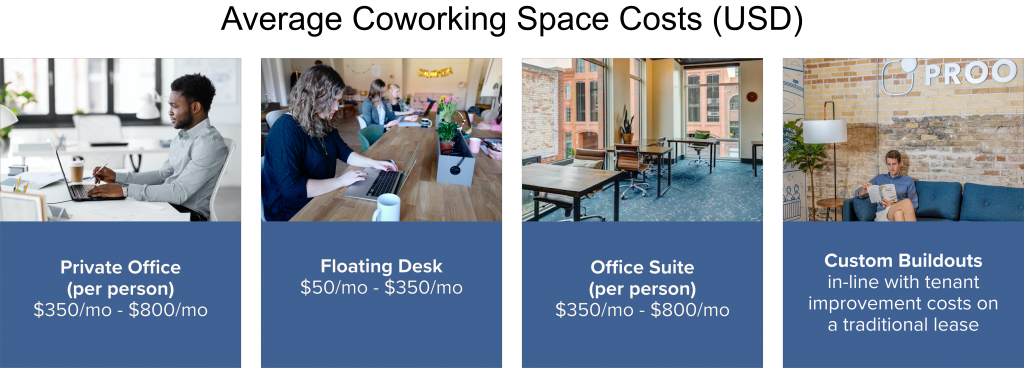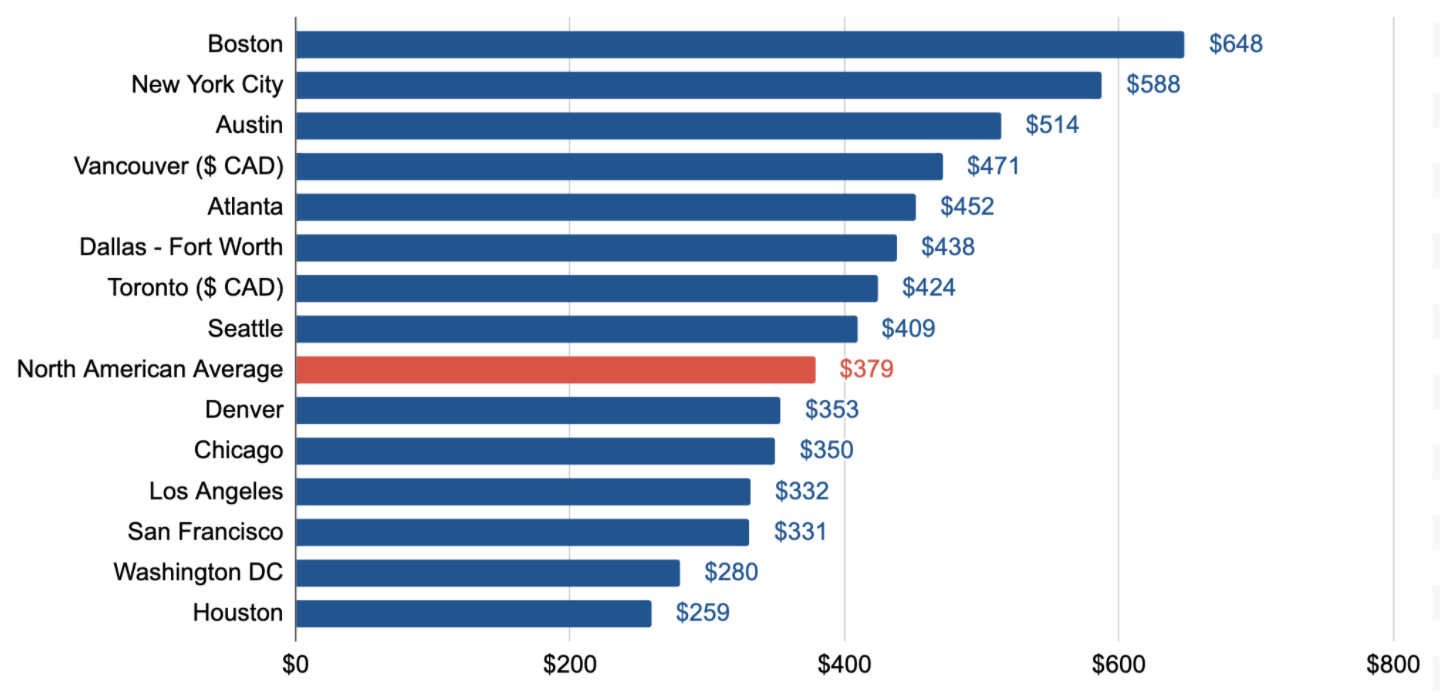[2021] Coworking Space Costs & Average Membership Pricing
Companies of all shapes and sizes gravitate towards coworking space for its flexibility. While the spaces themselves can mold themselves around an enterprise’s specific needs, that sense of flexibility extends to agreement terms and pricing as well.
To help you make an informed decision for your organization’s next workspace, we’ve put together a brief but informative guide on coworking space costs, average membership pricing, and how they differ from traditional office leases. We’ll discuss several topics and questions throughout, including:
- Coworking space costs versus traditional office costs
- Coworking pricing structures & fee types
- Why coworking pricing differs – location, amenities, etc
- Average coworking costs per seat in major markets
- Is the price worth it for your team?
Use these insights to gain a better understanding of the pricing options available so your coworking space becomes a distinct point of strength for your team, operations, and future.
Differences Between Coworking Costs & Traditional Office Costs
One of the most appealing aspects of coworking is the simplicity of its pricing structures, especially in comparison to traditional office leases. Coworking price structures are usually dependent on a few different factors, first and foremost, the length of the agreement. Typical coworking service agreements range from month-to-month to two years, with an average term in the six-month range. Naturally, this is quite different from a traditional lease, where for a market like Manhattan, something as long as ten years is still considered short-term in some circles.
Read Next: [2021] The Largest Coworking Companies: WeWork & Top Competitors
However, if you’re new to coworking and just now starting to research everything available, there are a few other important differences between flexible space agreements and the traditional leases you might be more familiar with.
- Tenants are responsible for furnishing the space with traditional leases. Coworking space comes fully furnished.
- Many coworking operators are willing to work with organizations on custom buildouts – moving walls, privacy features, branding elements, and others – without complex improvement allowances typically included in a traditional lease.
- Coworking agreements provide wifi, outfitted kitchens, and other services/amenities that traditional leases do not include.
- In traditional space, you’re most likely staffing an office manager or assigning employees for basic housecleaning tasks, perhaps hiring a cleaner as well. Your coworking membership provides all of those services.
- Since traditional leases are longer-term agreements, they usually come with the right to sublet as well as release the space. Given the shorter coworking agreements, however, you would simply leave the space.
- A coworking agreement will include common area maintenance costs as part of the contract. With a traditional lease, you’re paying your portion of the building’s overall maintenance costs, including utilities, common area cleaning, or even capital improvements to the building. Since these are variable costs, footing the bill for your part of overall operating costs can be a very unwelcome surprise from year to year since you never know exactly what rent you’ll be paying for the next 12 months.
- Coworking agreements don’t have the termination penalties common in traditional leases.
Not-So-Hidden Coworking Costs
It’s always a best practice to make sure you understand precisely what is and isn’t included in your coworking service agreement since amenities and fees can and do differ between operators and locations. For instance, some operators include free coffee from an onsite coffee shop, whereas others make you buy your own. The same holds true for things like conference room time, printing, and other services. Also, some providers provide receptionist and virtual office services, while others don’t offer them as an option.
Make sure you understand precisely what is and isn’t included in your coworking service agreement.
Also, most operators do not provide parking spaces in an agreement, although this is an amenity that is starting to get a bit more common. Other potential additional costs include extra network security for companies that work with sensitive data or IP, as well as per-seat setup costs. These are the types of items you should bring up during your coworking space tour to ensure you know exactly what comes with your service agreement and what does not.
Read Next: [2021] Coworking Space Agreements & Contracts (Template Included)
Average Coworking Space Costs
Offering everything from fractional seats and dedicated desks to custom buildouts and private offices, coworking provides office and desk space solutions to freelancers, startups, enterprises, and massive global conglomerates alike. The trick, of course, is to find the flexible space solution that fits your own team and goals best.
Aside from the type of space, several other factors will influence the pricing in a coworking space, including:
- Location
- Agreement term
- Amenities
- Services offered
That said, it’s important to keep in mind that the following average coworking space costs are just that – averages. In other words, it’s crucial to research price points in your desired areas using the most recent and relevant information possible.

Although office suites are typically a combination of private office, meeting room, and some shared space, note that their average price tends to be very similar to straightforward private office space. While there’s certainly a correlation between square feet and price, office suites generally house more employees than a private office.
It’s the higher number of employees per square foot – along with longer average agreement terms – that bring office suite price points down to the same level as private offices, despite the additional specialized areas and size in office suites. Also, as a point of reference, the average cost per seat in traditional space is closer to $250 to $500/mo, but typically includes significant upfront and ongoing costs that coworking doesn’t require, as discussed above.
Major Market Average Coworking Prices
As we said, location plays a significant role in the amount you’ll pay per month for a coworking space. Comparing the costs and economic benefits between two wildly different markets – Manhattan vs. Salt Lake City, for instance – is very much apples-to-oranges.
That said, we wanted to give you an idea of what average coworking costs per seat look like in the biggest markets. Rather than relying on static & outdated information, we’ve culled the following data from our own search map – it’s the most up-to-date, relevant, and accurate pricing information available in the market.
Average Costs Per Person for Coworking, Top Markets, Q1, 2021
Source: Flex Office Pro Market Data and Insights Platform
Is Coworking Worth It for Your Organization?
Coworking might not be a perfect fit for every organization’s needs but, considering how quickly the flexible real estate industry is expanding and evolving, it should, at the very least, be a consideration during your search. Given the list of attractive amenities & perks, furnishing, flexible terms, and affordable price points, coworking is already an integral piece of the operational puzzle for everyone from remote workers and small business owners to Fortune 500 companies.
Our advice is to do your research, have a firm understanding of the coworking environment, and see if it’s a good fit for your needs. If it’s not, then there’s a good chance it probably will be in the near future.


This Post Has 0 Comments